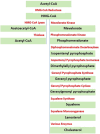Impact of statins in the liver: A bane or a boon?
- PMID: 40677525
- PMCID: PMC12269231
- DOI: 10.3138/canlivj-2023-0028
Impact of statins in the liver: A bane or a boon?
Abstract
Treatment of hypercholesterolemia with statins is considered one of the cornerstones in the management of atherosclerotic cardiovascular diseases. Statins exert their hypolipidemic effects by inhibiting HMG-CoA reductase, the key enzyme in cholesterol biosynthesis. Beyond cholesterol reduction, statins exhibit pleiotropic effects, including anti-inflammatory, antioxidant, and antiproliferative actions, making them valuable in mitigating atherosclerotic and non-atherosclerotic diseases. Though concerns of hepatotoxicity have been associated with the use of statins, extensive evidence suggests that the risk of statin-induced liver injury (SILI) is rare, with an incidence of <1%. Hepatic adverse effects include reversible asymptomatic transaminase elevation (most frequent), hepatitis, cholestasis, and rarely acute liver failure. While hepatotoxicity concerns should not be dismissed, the evidence overwhelmingly supports the safety of statins. Contrary to the myth of statin hepatotoxicity, real-world data and extensive research emphasize the safety and benefits of statins. They are therapeutic in various liver-related conditions, mainly non-alcoholic fatty liver disease. This scientific review aims to provide a comprehensive overview of statins, shedding light on their mechanism of action, hepatotoxicity concerns, and therapeutic potential in various liver-related conditions.
Keywords: DILI; HMG-CoA reductase; hepatic adaptation; hepatotoxicity; statins.
© Canadian Association for the Study of the Liver, 2024.
Conflict of interest statement
N/A
Figures
References
-
- Keys A. Coronary heart disease in seven countries. Circulation. 1970;41(Suppl. 1):1–211 - PubMed
-
- Kannel WB, Dawber TR, Kagan A, Revotskie N, Stokes J. III. Factors of risk in the development of coronary heart disease—six year follow-up experience. The Framingham Study. Ann Intern Med. 1961;55(1):33–50 - PubMed
-
- Endo A. The discovery and development of HMG-CoA reductase inhibitors. J Lipid Res. 1992;33(11):1569–82. PMID: - PubMed
-
- https://www.researchandmarkets.com/report/statin (Accessed October 1, 2023).
Publication types
LinkOut - more resources
Full Text Sources
Medical



